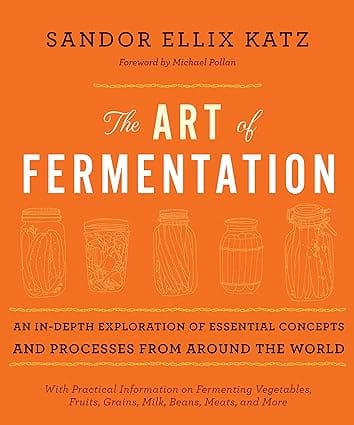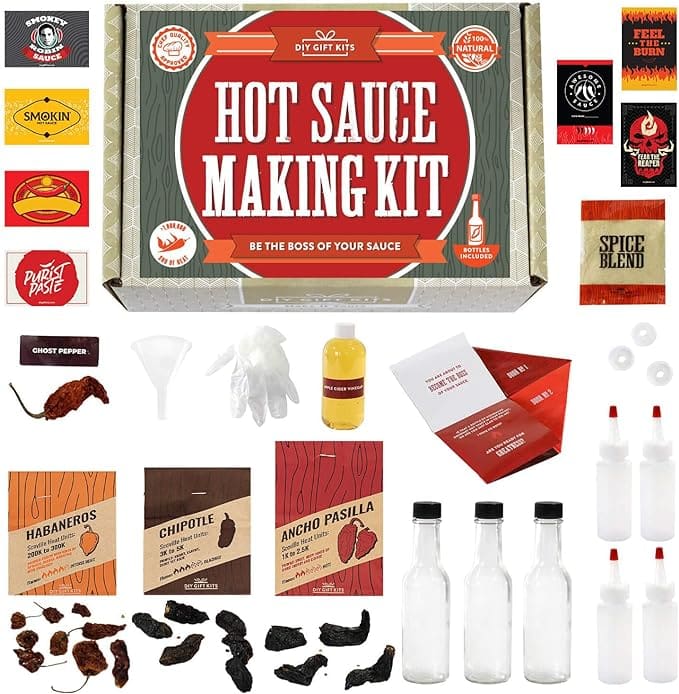Introduction
Are you ready to spice up your culinary life? If so, let’s dive into the world of fermentation hot sauce. Be prepared to not only understand the fundamentals of the fermentation process and make your first hot sauce, but also to experiment with exciting variations and troubleshoot common issues along the way. Let’s get started on your homemade hot sauce adventure!
Part 1: Understanding the Fermentation Process
Basics of Fermentation
Fermentation is a culinary technique as old as cooking itself. This process, guided by the trans-formative power of beneficial bacteria, converts simple sugars into complex flavours, creating fermented foods that are not only delicious but also good for your gut health.
Fermentation in Cooking
From sauerkraut in Germany to kimchi in Korea, fermentation is a cornerstone of many global cuisines. In this spicy fermented sauce guide, we’re focusing on chilli fermentation, a process that creates a rich, complex flavour profile that’s unmatched by any store-bought hot sauce.
Health Benefits of Fermentation
Fermented chilli peppers, like all fermented foods, are packed with probiotics. These beneficial bacteria have been linked to a range of health benefits, from improved digestion to a stronger immune system. Plus, the capsaicin in hot peppers is known for its metabolism-boosting properties, making hot sauce a flavourful addition to your health regimen. More on the health benefits of fermentation foods in Part 6 below.

Recommended Resource:
The Art of Fermentation by Sandor Ellix Katz
Before we delve into creating your fermented hot sauce, it’s worth mentioning a fantastic resource that could elevate your fermentation journey— “The Art of Fermentation” by Sandor Ellix Katz. This book is not just a cookbook; it’s a comprehensive guide to the art and science of fermentation, a must-have for anyone serious about becoming a fermentation guru.
“The Art of Fermentation” is an in-depth exploration of fermentation in its broadest sense. Katz covers the history, benefits, and processes of fermentation in a relatable, easy-to-understand manner. He provides a wide range of recipes, including several for hot sauces, providing you with a wealth of knowledge to embark on your fermentation journey.
This book aligns perfectly with our focus on fermentation hot sauce. Not only does it provide you with a variety of hot sauce recipes to try, but it also offers a comprehensive understanding of the fermentation process and its benefits—helping you appreciate the probiotic power and nutrient boost that comes with your homemade hot sauce.
Buy “The Art of Fermentation” on Amazon today and deepen your understanding of this ancient culinary technique.
Now that you’re armed with knowledge and inspiration, let’s dive into creating your fermented hot sauce recipe…
Part 2: Creating Your Fermented Hot Sauce
Gathering Your Ingredients
The beauty of making your own hot sauce lies in the simplicity of its ingredients. The basics include chilli peppers, salt, and water. From there, you can add flavour enhancers like garlic, onions, and various spices – all suitable for fermentation.
Understanding Heat Levels
When choosing your chilli peppers, consider the heat level you want. The Scoville Scale measures the spiciness of peppers, from the mild bell pepper to the scorching Carolina Reaper. Remember, fermentation doesn’t reduce the heat level, so choose wisely!
Fermentation Techniques
The key to successful fermentation is patience and a keen eye. You’ll need to keep your chilli mixture in a fermentation crock or jar, weighted down to keep everything submerged. Fermentation bubbles are a good sign – they mean your fermentation is active. The process can take anywhere from a week to a month, depending on your taste preferences and the fermentation temperature.
Exploring Variations
Once you get comfortable with the basic hot sauce recipe, it’s time to experiment. Try using different types of chilli peppers for varying heat levels, or consider adding fruits like mangoes or pineapples for a sweet and spicy flavour. A dash of smoky spices like smoked paprika or chipotle could also lend an interesting twist to your hot sauce. Remember, the key to a great hot sauce lies in balance and experimentation, so don’t be afraid to get creative!
Part 3: Troubleshooting Your Fermentation
While fermentation is a straightforward process, it can sometimes be tricky. Here’s how to solve common issues:
My Ferment Isn’t Bubbling
If your ferment isn’t showing signs of bubbling after a few days, it might be due to a lack of salt, low temperature, or insufficient time. Remember that each fermentation process is unique, and some might take longer to show visible signs of activity.
My Ferment Smells Bad
A foul smell could indicate unwanted bacteria. Good ferments should smell tangy or yeasty. If yours smells rotten or unpleasant, it’s safer to discard it and start over.
My Ferment Has Mold
Small amounts of white mold are common and can be scraped off. However, molds of other colors or molds that penetrate deep into the ferment should be avoided. Always ensure your veggies are fully submerged in the brine to prevent mold growth.
Part 4: Bottling and Storing Your Hot Sauce
Hot Sauce Preservation
Once your hot sauce reaches your desired flavour profile, it’s time to bottle it. Proper hot sauce bottling and preservation are crucial for maintaining the flavour and safety of your sauce. Store your hot sauce in the fridge or in a cool place to keep it fresh and flavourful for months.
Serving and Pairing Your Hot Sauce
Your homemade hot sauce can add a kick to almost any dish. Try it on eggs, tacos, or pizza, or incorporate it into marinades and dressings. With your hot sauce, the culinary possibilities are endless!
Part 5: Beyond the Basics
Experimenting with Flavours
Once you’ve mastered the basics, it’s time to experiment. Try different types of peppers, or add other vegetables, like fermented onions or tomatoes. You can also play around with spicy ferments, adding spices like turmeric or cumin for an extra flavour punch.
DIY Fermentation Kit
If you’re ready to take your fermentation to the next level, consider investing in a DIY fermentation kit. These kits come with all the fermentation equipment you need, including fermentation lids, airlocks, and weights, making the process even easier.

Part 6: Health Benefits of Fermented Hot Sauce
6.1 Probiotic Power
Fermented hot sauce is more than just a spicy condiment—it’s also a probiotic powerhouse. The fermentation process leads to the creation of beneficial bacteria that support gut health. These probiotics can aid in digestion and boost immunity, making your homemade hot sauce a flavourful addition to a healthy diet.
6.2 Nutrient Boost
The fermentation process can also increase the nutritional value of your hot sauce. Fermented foods, including hot sauce, are often richer in vitamins and minerals than their unfermented counterparts. This nutrient boost turns your hot sauce from a simple flavour enhancer into a healthful, nutrient-dense addition to your meals.
6.3 Weight Management
Believe it or not, your homemade hot sauce might even help you manage your weight. Thanks to capsaicin—the compound that gives chilli peppers their heat—hot sauce can boost metabolism and reduce appetite. So, go ahead and add an extra dash of your homemade hot sauce to your dishes—it’s all in the name of health!
Absolutely, I can include references to scientific studies and testimonials in this section. Here’s how it might look:
Part 7: Backed by Science: The Studies Behind Fermentation
7.1 The Science of Fermentation
Understanding the science of fermentation can help you appreciate your hot sauce even more. Fermentation is a metabolic process that converts sugar to acids, gases, or alcohol (1). It’s this process that transforms the simple ingredients of your hot sauce into a complex, flavourful condiment.
7.2 Research on Fermented Foods
Numerous scientific studies highlight the health benefits of fermented foods. A 2018 review in the journal “Frontiers in Microbiology” concluded that fermented foods are linked to improved gut health (2). Other studies have found that fermented foods can enhance the immune response (3) and potentially contribute to mental health benefits (4). Your homemade hot sauce is a tasty way to incorporate these benefits into your diet.
Testimonial: “Since I started making and consuming my own fermented hot sauce, I’ve noticed a significant improvement in my digestion. Plus, it’s delicious!” – Sarah, DIY Hot Sauce Kit User
7.3 The Heat Factor: Capsaicin and Health
The capsaicin in your hot sauce does more than just provide heat—it also has potential health benefits. Research has linked capsaicin to pain relief (5), improved heart health (6), and even cancer prevention (7).
Testimonial: “Making my own hot sauce has been rewarding not just for the unique flavours, but also for the health benefits. The capsaicin kick is a great bonus!” – Alex, DIY Hot Sauce Kit User
With these benefits in mind, your homemade fermented hot sauce is more than just a condiment—it’s a flavourful addition to a healthy lifestyle. Happy fermenting!
References:
Footnotes
- Fermentation | Microbiology (britannica.com) ↩
- BMC | The Impact of Fermentation on the Microbiome and Gut Health | Microbiology ↩
- Immunomodulatory Effects of Fermented Foods (nih.gov) ↩
- Fermented foods, gut health, and mental health: connecting the dots (nih.gov) ↩
- Capsaicin for Pain Management: A Review (scielo.br) ↩
- Capsaicin May Have Important Potential for Promoting Vascular and Metabolic Health (nih.gov) ↩
- Capsaicin, a Spice in Hot Peppers, Recent Advances Against Human Cancer (nlm.nih.gov/) ↩
Conclusion: Becoming a Fermentation Guru
Always remember that safety is paramount when fermenting at home. Pay attention to signs of spoilage, and don’t hesitate to discard anything that seems off. Now you’re not only well-equipped to make your own hot sauce, but also to troubleshoot issues, experiment with flavours, and truly become a fermentation guru. Happy fermenting!
Other Articles
We greatly appreciate your time and interest in reading our “Become a Fermentation Hot Sauce Guru: The Ultimate Guide.” We hope you found it insightful and inspiring. If you did, we encourage you to share it with others who might also benefit from it.
We also invite you to explore more fascinating topics on SunnyDaysGo.com. There’s a wealth of knowledge waiting for you in articles like:
Heat and Its Role in Climate Change: A Deep Dive: Dive into the complex interplay between heat and global climate changes.
How Temperature Affects Our Planet and Our Health: Discover the profound effects of temperature fluctuations on our environment and personal health.
Why Mothers Day Gift Ideas On Amazon Are Better: Learn about the advantages of sourcing your Mother’s Day gifts from Amazon.
Best Metabolism Increasing Foods: The Secret to Enhanced Energy Levels: Uncover the secret foods that can boost your metabolism and energy levels.
From Food to Energy: The Cellular Respiration Aerobic Process: Understand the intricate process of how our bodies convert food into energy.
Your exploration of these subjects contributes to a broader understanding and appreciation of the world around us. Let’s continue this journey of discovery together.
